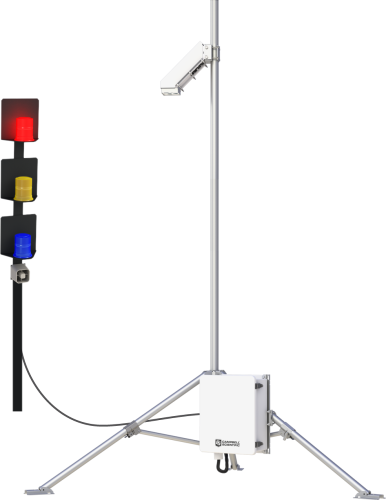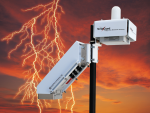This product is not available for new orders.

| Services Available |
|---|
Overview
The LW110 provides continuous monitoring of the local electric field and triggers warnings when there is the potential for lightning. Because warnings are based on measurements of electric field, instead of prior strikes, the system can detect lightning danger, even when no other strikes have occurred.
By measuring the electric field at your location, the LW110 can be relied upon to remove the guesswork from critical decisions: when to seek shelter as a storm approaches, and when it’s safe to resume activities as a storm passes.
The LW110 is customizable, allowing you to add a lightning strike detector, meteorological sensors, and various communication, power, and mounting options.
Benefits and Features
- First strike warning--senses potential for lightning
- "All clear" notices when lightning threat has passed
- Up to 7 mile detection radius
- Visual and audible alarms
- PC, web, and email alarms when communication is added
- Optional SG000 detects strikes up to 20 mile radius and can be added to create a complete lightning-threat measurement and analysis system
- Optional meteorological sensors for expanded weather monitoring and logging
- Rugged construction
- Low power consumption
- Low maintenance—extensive diagnostics let you know when maintenance is needed
See how one of our systems is helping keep events at Utah schools safe from lightning on KSL.com.
Images

Similar Products
Compatibility
|
IMPORTANT! The CS110 should not be run with OS 28 (CR1000.Std.28.obj). A bug in OS 28 prevents changing the setup "Constants" via the keyboard or the terminal emulator. |
Documents
Brochures
Frequently Asked Questions
Number of FAQs related to LW110: 3
Expand AllCollapse All
-
The CS110 and the tower should be positioned away from each other a distance of three times the tower’s height.
If the radio signal is strong enough, the SG000 may pick it up as one of the two components the SG000 measures to detect lightning. If this signal coincides with a light flash from a windshield or headlight, it could generate a false strike signal. Also, constant bombardment of the SG000 by sufficiently strong RF signals will pull the sensor out of its quiescent state, affecting its current drain. This will eventually degrade the battery and shorten its expected four-year lifespan.
-
To simulate a lightning strike to the SG000, use a camera flash to flash the glass bulb from a distance of 5.08 to 7.62 cm (2 to 3 in.). Note: A flash from a cell phone usually isn't large enough to simulate a lightning strike.
To simulate high electric fields on the CS110, run a comb through your hair and hold it a distance of 2.54 to 5.98 cm (1 to 2 in.) from the shutter of the CS110. Other items such as plastic bags or balloons, or fur on glass, can be used as well.
-
The FC100 is required to communicate with the SG000 Strike Guard Lightning Sensor. The SG000 is an option for the CS110 Electric Field Sensor and the LW110 Lightning Warning System.
Case Studies
The Professional Golfers’ Association Tour (PGA Tour) of America contracted with Schneider Electric to provide......read more
Lightning strikes are a serious concern for school officials who are responsible for protecting the......read more
Lightning kills about 40 people a year in the highland areas of Peru. This startling......read more
Articles and Press Releases
Privacy Policy Update
We've updated our privacy policy. Learn More
Cookie Consent
Update your cookie preferences. Update Cookie Preferences



